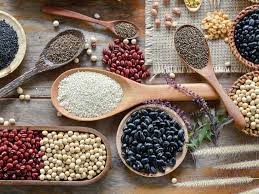By Mila McManus MD
The study of lectins is an extensive and emerging area of science with far-reaching implications to both health and healing. Learning about them may be a significant game changer for your health. The findings may even surprise you. It is quite possible that lectins are the hidden cause behind many symptoms and diseases. If you struggle to lose weight, have autoimmune disease, digestive issues, or have stubborn health problems that just don’t seem to improve or resolve, learning more about lectins may be time well spent.
Lectins are a large class of proteins that can be found in all forms of life. In plants, lectins are the natural defense system that protect the plant from destruction by microorganisms, pests, and insects[1]. Lectins make the plant leaves unappetizing, poisonous to invaders, or signal by color to the animal when a fruit is ready to eat. For example, during the growing process, a fruit will be green and high in lectins, therefore harmful and toxic to an invader. Later, the fruit will reach ripeness, turning a bright color, signaling to animals that the fruit is ready to be eaten. At ripeness, the lectin content has dropped and is no longer toxic to the predator. When the animal eats the fruit, it carries the seeds in the digestive tract to another area, and then defecates the seeds into a new place to grow, thus perpetuating the plant species. Lectins are in the seed’s outer coating as well as inside the seed on what will become the leaves once the seed sprouts.
Lectins are often referred to as “sticky proteins” because they are attracted to cell surfaces, causing cells to clump together (called agglutination). One extreme example is ricin, a lectin found in castor beans. It is such a potent lectin that just a minuscule amount ingested can cause death due to massive clotting of red blood cells from agglutination[2]. Another more familiar lectin is gliadin (a.k.a. wheat germ agglutinin or WGA). WGA is a component of gluten, the most well-known lectin of our time. Again, think of the “sticky” nature of lectins. Lectins bind to cells in the gut, blood, nerves, muscles, and joints, just to name a few. There, they act as chemical messengers, but their message is harmful, not helpful. It is a message to inflame and a message to wreak havoc. WGA is involved in almost every acute and chronic inflammatory disorder including neurodegenerative disease, inflammatory bowel disease, infections and autoimmune diseases².
Not all lectins are harmful, and some are even beneficial. Our focus today is on the lectins which inflict damage to the human body in the following ways:
- Lectins from the diet damage the delicate intestinal lining, increasing gut permeability and compromising protein digestion[3].
- Lectins can be transported across the intestinal membrane into general circulation where they may attach to other tissues (connective, nervous, bladder) causing immune dysfunction and systemic inflammation³.
- Lectins are chemical messengers potent enough to initiate and aggravate existing inflammatory conditions including autoimmune diseases (e.g. thyroiditis, lupus, rheumatoid arthritis, fibromyalgia) ³.
- Lectins have a significant impact on metabolism and weight gain. Normally, insulin acts like a delivery truck for excess carbohydrates (glucose) by attaching itself to the insulin receptor site (think loading dock) found on fat cells. Here, insulin tells the fat cell to open the storage room door, so that glucose can be moved into the fat cell for storage. Once the glucose has been stored as fat, the insulin backs away from the loading dock receptor site, and the fat cell locks up the door to the storage room. In many people, lectins disrupt this process in a significant way. Remember, the lectins are sticky. Lectins stick to the insulin receptor site (the loading dock) on the fat cell, mimics insulin by instructing the fat cell to open the storage room door and move glucose into storage as fat. However, lectins do not back away but instead stay indefinitely attached (stuck) to the receptor site giving a constant message to store fat².
Lectins do present a paradox. On one hand, plants are essential for good health and small amounts of lectins can be handled and managed by a healthy body. On the other hand, the wrong plants, eaten routinely and abundantly, can result in a cumulative toxic impact to the body over time. The same plant toxins that can kill or immobilize an insect can also silently destroy your health and insidiously impact your weight. Your current health status, family history, and genetic individuality will determine your body’s ability to recognize lectins as friends or foe.
We now have access to a lab test for lectin sensitivity for those who want to see results in writing before launching into a lectin reduction diet. Our supplement of the month is another helpful resource, as it works to block lectins from the gut surface and passage through it.
To find out more, read today’s Nutrition Nugget . There, we will address which high lectin foods are most damaging and best avoided, and which lectin foods can be prepared in ways that reduce the lectin content. For a more in-depth study of lectins, you may want to read The Plant Paradox, by Dr. Steven R. Gundry, MD., where you will also be introduced to his Plant Paradox Program diet.
[1] Peumans WJ, Van Damme EJ. Lectins as plant defense proteins. Plant Physiology. 1995;109(2):347-352
[2] Pierini, Carolyn M. Lectins: Their Damaging Role in Intestinal Health, Rheumatoid Arthritis and Weight Loss. Vitamin Research News. 2007;21(1):1-4
[3] Pierini, Carolyn M. Lectin Lock™:Natural Defense Against a Hidden Cause of Digestive Concerns and Weight Gain. Vitamin Research News.2007;21(2):6

